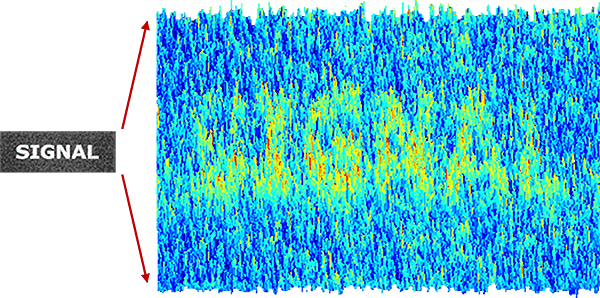
The Signal to Noise Ratio
- Formal: the ratio of the strength of an electrical or other signal carrying information, to that of interference, generally expressed in decibels.
- Informal: a measure of how much useful information there is in a system, such as the Internet, as a proportion of the entire contents.
Signal is meaning detected against a background of meaninglessness, or Noise. This is something you and I never stop doing. You are doing it to read this on the screen and doing it again more subtly to decide whether I’m full of crap, then more subtly still, to decide if you care one way or the other. Our need to discern is endless. An animal using stealth or mimicry to catch prey or to escape becoming prey is imitating noise. Detecting signal can easily be a matter of life and death.
If you read my article on apophenia (seeing connections and meaning in data because we want it to be there, not because it really is,) you’ll note a connection. The signal to noise ratio is what goes haywire in apophenia. There is a breakdown in the ability to NOT see meaning and connection. This issue often goes critical in schizophrenia and major personality disorders. Seeing meaning where it isn’t is as out of balance and dangerous as not seeing it where it actually is. Clearly, being in touch with reality is a balancing act. It’s easy to overlook things and it’s easy to become too wrapped up in outcomes we care about. There is no golden midline of correct balance for us to walk as every discipline is uneven and imperfect, every culture is hidebound to iron-age realities and the world itself is a giant game of where the rules can appear to shift daily.
There is hardly an aspect of our lives where we don’t need to distinguish signal from noise, and frequently. I’ll spare you one of my big lists but every effort to detect safety, honesty, accuracy, and health, for example, requires this filter.
When we turn from life in general to truth-finding disciplines like science, this activity changes from something that supports our pursuits to the entire pursuit itself. Science is the discipline of finding creative ways to make signal, if it is present, contrast revealingly against noise. To succeed, science requires an infrastructure of principles and practices most likely to make results unambiguous and repeatable. People being people though, these operational principles can easily morph into in-group identity issues about taking sides and showing loyalty.
I have written a bit about this struggle elsewhere on this site. It is known as reductionism, the critical thinking technique that is biased against signal, and in favor of noise: We could describe it as a belief in noise as the default state of everything unless proven otherwise. It is intended as a neutral filter against positive scientific apophenia (confirmation bias) but it frequently plays out as negative scientific apophenia (rejection bias). In this role, it suppresses interpretations of results suggesting meaning, connection or complexity. It assumes the universe is a stochastic (random) process and that’s a sensible, clean, unmuddied premise. The problem is that it so naturally becomes a belief system rather than a nice clean canvas.
Please hit play and watch these random stupid dots move around meaninglessly, for no particular reason.
If those dots kept on as they began, it’s unlikely you would have perceived all those levels, is that safe to say?
When we look at background noise and detect no process or pattern in it we might feel disappointed or relieved but the larger question is, do we know enough about potential processes or patterns that we can be certain that what appears random to us really is? Or whether the “wavelength” of the process is one we can see and measure?
The deeper message is you probably won’t know meaningful signals from noise unless you are looking very hard and creatively at the right zoom level in the right place while balancing the correct question on your nose like a seal. Naturally, we pick up the easy, large chunks of meaning and wall mount them as the whole story, but moving forward our predicament calls for a kind of inspired, transcendental agnosticism. If scientific research was yoga (yes, I said that) the proper asana for considering unknowns is the corpse pose: Breath, relax and imagine, then when ready, bend and stretch.